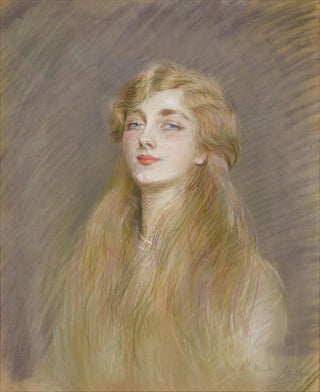Art print | Portrait of Mlle Blanche de Pas - Paul César Helleu


View from behind

Frame (optional)
In the fascinating world of art, some works manage to capture the very essence of their subject, transcending mere portraiture to become a true window into the soul. The "Art print of Mlle Blanche de Pas" by Paul César Helleu is one of these magical creations. Created at the end of the 19th century, this painting highlights the delicate beauty and timeless elegance of its model, Blanche de Pas, who embodies both modernity and refinement of her era. By immersing oneself in this artistic universe, one discovers a work that, beyond its simple representation, invites deep contemplation and an appreciation of life's nuances.
Style and uniqueness of the work
Helleu's style is distinguished by his ability to combine precise technique with a light and airy atmosphere. In this portrait, the finesse of Blanche de Pas's features is accentuated by delicate, almost brushed strokes that seem to dance across the canvas. The chosen colors, ranging from soft pastels to more vivid shades, create a harmonious contrast that draws the eye and captivates the mind. Helleu does not merely reproduce an image; he manages to convey a palpable emotion, a kind of gentle melancholy that envelops the viewer. The pose of the model, her gaze both dreamy and penetrating, as well as the carefully crafted details of her attire, demonstrate meticulous attention to every element, thus reinforcing the uniqueness of this work.
The artist and his influence
Paul César Helleu, an emblematic figure of the Impressionist movement, knew how to leave his mark on his time with his refined portraits and scenes of Parisian life. Influenced by the great masters of his era, he developed a style that is uniquely his own, blending realism and impressionism. His innovative approach paved the way for many artists, and his work has been praised for its ability to capture the spirit of the Belle Époque. Helleu also established himself as a preferred portraitist for aristocracy and influential personalities of his time, which attests to the recognition of his talent. Through his works,

Matte finish

View from behind

Frame (optional)
In the fascinating world of art, some works manage to capture the very essence of their subject, transcending mere portraiture to become a true window into the soul. The "Art print of Mlle Blanche de Pas" by Paul César Helleu is one of these magical creations. Created at the end of the 19th century, this painting highlights the delicate beauty and timeless elegance of its model, Blanche de Pas, who embodies both modernity and refinement of her era. By immersing oneself in this artistic universe, one discovers a work that, beyond its simple representation, invites deep contemplation and an appreciation of life's nuances.
Style and uniqueness of the work
Helleu's style is distinguished by his ability to combine precise technique with a light and airy atmosphere. In this portrait, the finesse of Blanche de Pas's features is accentuated by delicate, almost brushed strokes that seem to dance across the canvas. The chosen colors, ranging from soft pastels to more vivid shades, create a harmonious contrast that draws the eye and captivates the mind. Helleu does not merely reproduce an image; he manages to convey a palpable emotion, a kind of gentle melancholy that envelops the viewer. The pose of the model, her gaze both dreamy and penetrating, as well as the carefully crafted details of her attire, demonstrate meticulous attention to every element, thus reinforcing the uniqueness of this work.
The artist and his influence
Paul César Helleu, an emblematic figure of the Impressionist movement, knew how to leave his mark on his time with his refined portraits and scenes of Parisian life. Influenced by the great masters of his era, he developed a style that is uniquely his own, blending realism and impressionism. His innovative approach paved the way for many artists, and his work has been praised for its ability to capture the spirit of the Belle Époque. Helleu also established himself as a preferred portraitist for aristocracy and influential personalities of his time, which attests to the recognition of his talent. Through his works,






